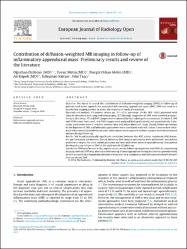| dc.contributor.author | Özdemir, Oğuzhan | |
| dc.contributor.author | Metin, Yavuz | |
| dc.contributor.author | Metin, Nurgül Orhan | |
| dc.contributor.author | Küpeli, Ali | |
| dc.contributor.author | Kalcan, Süleyman | |
| dc.contributor.author | Taşci, Filiz | |
| dc.date.accessioned | 2020-12-19T19:55:48Z | |
| dc.date.available | 2020-12-19T19:55:48Z | |
| dc.date.issued | 2016 | |
| dc.identifier.issn | 2352-0477 | |
| dc.identifier.uri | https://doi.org/10.1016/j.ejro.2016.08.005 | |
| dc.identifier.uri | https://hdl.handle.net/11436/2609 | |
| dc.description | ozdemir, oguzhan/0000-0002-7679-1983 | en_US |
| dc.description | WOS: 000399168500032 | en_US |
| dc.description | PubMed: 27570803 | en_US |
| dc.description.abstract | Objective: We aimed to search the contribution of diffusion-weighted imaging (DWI) in follow-up of patients with acute appendicitis associated inflammatory appendiceal mass (IAM). DWI was used as a monitoring imaging method to assess the response of medical treatment. Materials and methods: 19 patients (mean age, 37+-13.1; age range, 19-69; M/F: 10/9), presented with clinical, laboratory and computed tomography (CT) findings suggestive of IAM were enrolled prospectively in this study. CT and DWI images were evaluated by two radiologists in consensus. b values 0, 500 and 1000 s/mm(2) were used, and DWI images were analysed both qualitatively and quantitatively. Laboratory parameters were C-reactive protein value and white blood cell count. During follow-up changes in the diameter of IMA and laboratory parameters were correlated with ADC values. Conservative treatment with interval appendectomy and a total conservative approach without surgery were the treatment options during follow-up. Results: We found statistically significant correlation between the ADC values, maximum IAM diameter and laboratory parameters. During follow-up five surgical procedures were performed: one patient underwent surgery for cecal adenocarcinoma and four underwent interval appendectomy. One patient developed acute relapse of IAM at the sixth month of follow-up. Conclusion: DWI may be used with a significant success for follow-up of patients with IAM. As a monitoring imaging method, DWI may also aid in determining of most appropriate timing for interval appendectomy as well as may help in diagnosing alternative diagnoses (e.g. malignancy and inflammatory bowel disease) that can mimic IAM. (C) 2016 the Author(s). Published by Elsevier Ltd. | en_US |
| dc.language.iso | eng | en_US |
| dc.publisher | Elsevier Science Bv | en_US |
| dc.rights | info:eu-repo/semantics/openAccess | en_US |
| dc.subject | Inflammatory appendiceal mass | en_US |
| dc.subject | Diffusion-weighted imaging | en_US |
| dc.title | Contribution of diffusion-weighted MR imaging in follow-up of inflammatory appendiceal mass: Preliminary results and review of the literature | en_US |
| dc.type | article | en_US |
| dc.contributor.department | RTEÜ, Tıp Fakültesi, Dahili Tıp Bilimleri Bölümü | en_US |
| dc.contributor.institutionauthor | Özdemir, Oğuzhan | |
| dc.contributor.institutionauthor | Metin, Yavuz | |
| dc.contributor.institutionauthor | Metin, Nurgül Orhan | |
| dc.contributor.institutionauthor | Kalcan, Süleyman | |
| dc.contributor.institutionauthor | Taşci, Filiz | |
| dc.identifier.doi | 10.1016/j.ejro.2016.08.005 | |
| dc.identifier.doi | Özdemir, O., Metin, Y., Metin, N. O., Küpeli, A., Kalcan, S., & Taşçı, F. (2016). Contribution of diffusion-weighted MR imaging in follow-up of inflammatory appendiceal mass: Preliminary results and review of the literature. European journal of radiology open, 3, 207–215. https://doi.org/10.1016/j.ejro.2016.08.005 | en_US |
| dc.identifier.volume | 3 | en_US |
| dc.identifier.startpage | 207 | en_US |
| dc.identifier.endpage | 215 | en_US |
| dc.ri.edit | oa | en_US |
| dc.relation.journal | European Journal of Radiology Open | en_US |
| dc.relation.publicationcategory | Makale - Uluslararası Hakemli Dergi - Kurum Öğretim Elemanı | en_US |


















